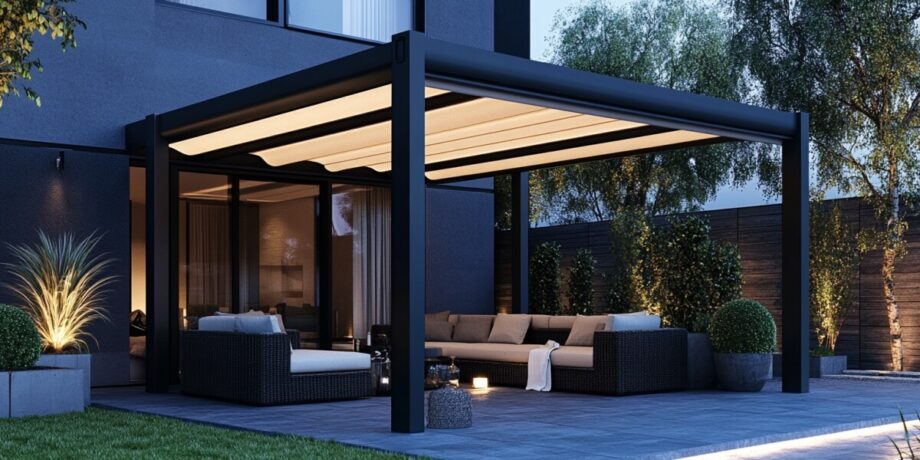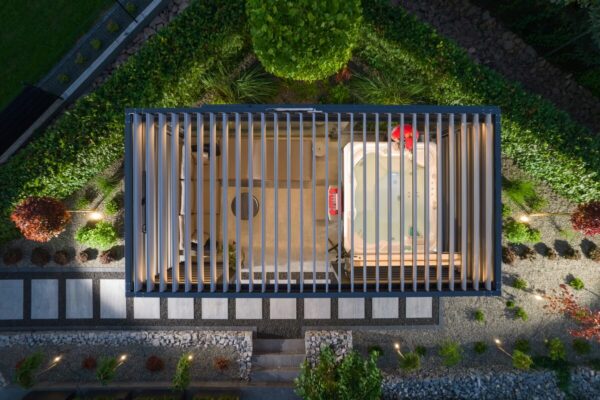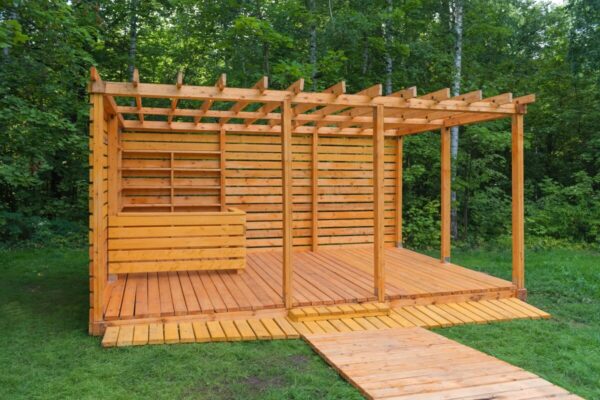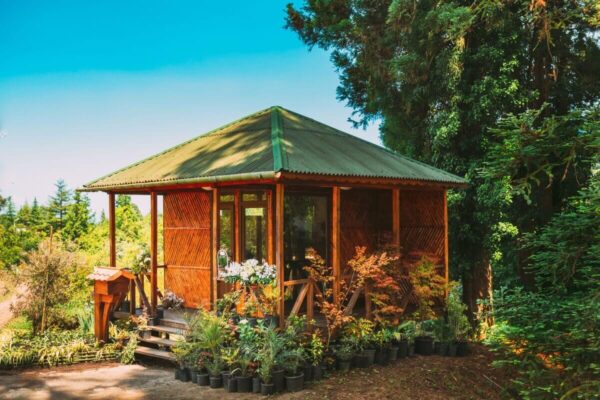Contents
- Incorporating traditional designs in wooden garden gazebos
- Modern interpretations: sleek and stylish wooden garden gazebos
- The beauty of natural elements in wooden garden gazebos
- Embellishing with decorative features
- Seasonal adaptability of wooden garden gazebos
- Most popular questions and answers
Incorporating traditional designs in wooden garden gazebos
When considering wooden garden gazebo design ideas, traditional styles often come to mind due to their timeless appeal and enduring functionality. A classic peaked roof design, typically covered in wooden shingles or even thatch, can lend your garden a rustic, charming feel. The use of latticework as a design element not only enhances the gazebo’s beauty but allows climbing plants to entwine around the structure, creating a naturally shaded retreat. Traditional gazebos also benefit from incorporating built-in seating, which makes them perfect for a leisurely afternoon tea or hosting garden parties that require a touch of elegance.
The interior of your traditional wooden garden gazebo can be designed to reflect a sense of nostalgia and comfort. Soft seating with cushions and perhaps a central table can promote an atmosphere that’s perfect for casual dining or reading. Effective use of perennial plants around the gazebo’s perimeter can soften its edges and ensure it is visually absorbed into the surrounding landscape. If you want to explore more about how such a design can enhance your outdoor space, you might consider asking, Why are wooden garden gazebos the perfect addition to your backyard?
Modern interpretations: sleek and stylish wooden garden gazebos
While traditional gazebos invoke a sense of timelessness, modern wooden garden gazebo designs are all about sleek lines and functional elegance. Modern designs often feature flat or slanted roofs for a minimalistic look, framed with light-colored wood that emanates a contemporary vibe. The use of glass elements, such as sliding doors or large windows, can open up the gazebo to the surrounding garden, offering unobstructed views and an airy feel. This approach doesn’t just maximize natural light but also merges the indoor and outdoor experience seamlessly.
A modern wooden garden gazebo can also serve as a multi-functional space, doubling as an outdoor dining area, home office, or cozy lounge. To maintain an uncluttered aesthetic, consider incorporating built-in furniture such as benches with storage compartments. This minimalist style complements gardens that lean towards the modern and contemporary, accentuating clean lines and open spaces. You can personalize such gazebos with various features like ambient lighting, which can turn the space into a warmly lit refuge during evening hours.
The beauty of natural elements in wooden garden gazebos
Natural elements have always been a vital consideration in garden design, and incorporating them into your wooden garden gazebo can significantly enhance its appeal and comfort. Choose wood types like cedar or redwood, known for their durability and beautiful aging process, which allows them to fit naturally into the landscape. Moreover, focusing on sustainability, opting for reclaimed wood can add environmental value to your gazebo design, making it both eco-friendly and aesthetically pleasing.
The concept of blending in can also be extended to plant life surrounding your gazebo. Select native plants and shrubs that complement the wood tones, such as fern beds or wildflowers that bring an organic touch to the area. Not only do these enhance the visual appeal, but they also promote local biodiversity, ensuring a sustainable ecosystem around your garden retreat. To maintain consistency with the theme, consider natural accessories like stone paths leading to the gazebo or wooden planters that seamlessly integrate with the gazebo’s structure.
Embellishing with decorative features
Decorative elements can transform a simple wooden garden gazebo into a personalized retreat that reflects your style and personality. One popular choice is to adorn the gazebo with hanging lanterns or string lights, providing a warm, inviting glow that makes nighttime gatherings magical. Stained glass windows or intricately carved wooden panels can add a touch of artistry and sophistication, elevating the gazebo from a mere shelter to an ornamental garden highlight.
- Hanging plants: They can be used to enhance the gazebo’s aesthetics, creating a lush, green canopy overhead.
- Outdoor curtains: For added privacy and a softer touch, outdoor curtains can be installed, offering shelter from the sun and wind.
- Water features: Incorporating a water feature near or around the gazebo can add an element of tranquility, with the sound of flowing water creating a peaceful ambiance.
These decorative features not only provide functional benefits but also cater to the sensory experience within the gazebo, enriching each moment spent in this outdoor environment.
Seasonal adaptability of wooden garden gazebos
A well-designed wooden garden gazebo should offer year-round usability, adapting seamlessly to the changing seasons. In colder climates, consider designs that can accommodate heating elements, such as an outdoor heater or even a built-in fireplace, ensuring warmth and comfort during the chillier months. The use of weather-resistant materials and finishes can also extend the lifespan of your gazebo, making it a durable and resilient addition to your garden.
In contrast, gazebos tailored for warmer climates can feature additional ventilation options, such as open sides or adjustable curtains, to maximize airflow and reduce heat. Add-ons such as ceiling fans can further enhance comfort during the hot summer days. Moreover, strategically placing your gazebo in a naturally shaded area of the garden can provide relief from direct sunlight, making it a cool retreat even in the height of summer.
In conclusion, designing a wooden garden gazebo involves more than simply choosing a structure—it is about creating a harmonious blend of style, function, and the natural environment. Whether you opt for a traditional design that exudes charm or a modern silhouette that speaks to sophistication, the variations are plentiful, and with careful planning, your gazebo can become a cherished part of your outdoor living space. As you consider these varied design ideas, remember that each choice should reflect personal preferences while enhancing the overall garden aesthetics and usability.
Most popular questions and answers
How do you maintain a wooden garden gazebo?
Regular maintenance is crucial to ensure the longevity of your wooden garden gazebo. Start by cleaning the structure with a mild detergent to remove dirt and debris. You should also apply a protective coat, such as a sealant or wood stain, once a year to safeguard against weather elements.
Can a wooden garden gazebo withstand harsh weather?
A well-constructed wooden garden gazebo can withstand various weather conditions if built with the right materials. Using durable woods like cedar or redwood and applying weather-resistant treatments enhances its resilience. Additionally, anchoring the gazebo securely will prevent damage during high winds.
What are the benefits of installing a gazebo in your garden?
Installing a wooden garden gazebo provides a versatile and attractive focal point for outdoor activities. It offers a shaded retreat for relaxation, dining, or entertaining guests. Moreover, it enhances the aesthetic value and can increase property marketability.
How can a gazebo be integrated with the garden landscape?
A gazebo can be seamlessly integrated into the garden landscape through thoughtful design and landscaping. Use complementary plantings like climbing vines and native flora to blend the gazebo naturally. Pathways or patios leading to the structure can further enhance its accessibility and visual appeal.
Is a building permit required to construct a garden gazebo?
Whether a building permit is required for a wooden garden gazebo depends on local regulations and the gazebo’s size. It’s essential to consult with local authorities or zoning offices to determine specific requirements. Following proper procedures ensures compliance and avoids future legal issues.




